Crypto Trading with Moving Average - Crypto Academy |S6W2| - Homework Post for Professor @shemul21
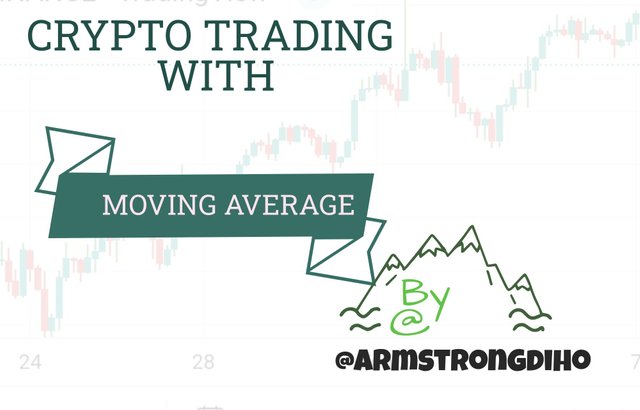

Explain Your Understanding of Moving Average.

Technical indicators are one of the best technical analysis tools in the trading box of any crypto trading platform, which critics or chartists used as a trading signal and as a signal confirmation respective. However, in the domain of trading systems with technical analysis, there are lots of technical indicators are designed to perform different works such as momentum-based, oscillation based, trend-based indicators.
Therefore, moving averages (MA) is one of the best and most popular indicators widely used by traders as a result of its simplicity to understand. Generally, looking at the nature of the MA on a chart, it moves when every new data point is formed and at the same time provide a good calculation of the point, and it does this calculation by using the average price of a past period interval.
IMAGE SHOWING MOVING AVERAGE ON THE CHART
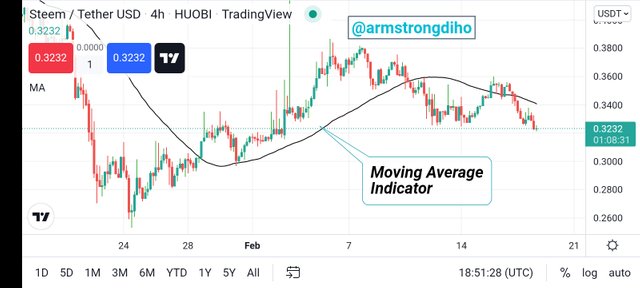
In the chart above, we have added the 50 moving average on the chart.
As such, the result includes a graph represented by a line that is modified over the price and the interpretation varies depending on the setting of the periods. That's the moving average is calculated using a mathematical equation of price data points to create the average price over time. The moving average calculates the average value of the asset price for a provided number of periods such as 50, 100, 200 etc. So, a 200 moving average will take the report of average data price points of the asset over the past 200 days.
The moving average is known to be one of the trend-based technical indicators which perform a key part in understanding and interpreting the trend direction of price within a timeframe. One basic part of this indicator is that it is arranged to any timeframe, and suitable for both the long term and short term traders. That's traders count on the MA to spot the recent price trend, possible trend reversal as price breaks above and below the moving average which can be used to identify dynamic support and resistance levels and future price reversal points respectively.
The MA data point is very helpful to traders as it enables them to filter out recent price fluctuations and minor movement in the market and picture trading signals in the market. Nevertheless, understanding and interpreting how the moving average work is very important since it eliminates or filters out some amount of market noise and minor movements, to nicely picture the direction of the trend.
Let's check out the following example of the moving average on the chart for better understanding.
IMAGE SHOWING MOVING AVERAGE ON THE CHART INDICATING AN UPTREND
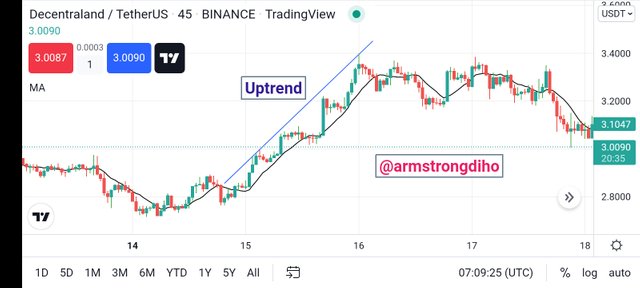
From the chart, we can notice the uptrend using the moving average, as such, identifying the current price trend is possible when using this indicator. From the chart, the asset price is currently trading above the moving average price which shows that price is in an uptrend.
I believe the above synopsis will provide a suitable understanding of moving average (MA).

What Are The Different Types of Moving Average? Differentiate Between Them.

Generally, there are lots of moving average indicators in technical analysis and varies in one way or the other. However, the major difference between these moving averages is the parameters. The different types of moving averages include The Simple Moving Average, The Exponential Moving Average, and The Weighted Moving Average.

√ Simple Moving Average (SMA)

A Simple Moving Average (SMA) is regarded as the simplest type of the moving average indicator, which is the technical line drawn by simply calculating the average of the prices of the periods considered. That's the technical line of the SMA drawn Plot the price fluctuates. Nevertheless, the SMA picture the mean price of an asset over a period considered.
Let's check the formula for the SMA as given below.
SMA = (M1 + M2 + ... + Mn)/N
where;
M = The price data points for each period.
N = the number of periods considered (50, 100, 200 days periods)

√ Exponential Moving Average(EMA)

The Exponential Moving Average (EMA) is a type of moving average that provides more key information about current price movement over a period. For this effect, the EMA reacts to price changes quicker than the SMA. However, the EMA was created as a remedy for the flaw in the simple moving average. That's the SMA reacts to prices not as fast as EMA, and provide last signals. However, both the SMA and the EMA are related and when combined, they provide price data which is very vital to make good trade decisions.
Traders mostly the Short term traders use the EMA to get current price information in the market. The formula for EMA calculation is given as;
EMAn = [ Cp × (s/1+n)] + EMAp × [1 - (s/1 + n)]
Where ;
EMAn = new EMA
Cp = Current price
EMAp = previous day EMA
s = Smoothing factor
n = number of periods

√ Weighted Moving Average (WMA)

The weighted moving average is another form of moving average indicator which provides trading signals to the trader. However, the Weighted Moving Average (WMA), dedicates weights to the different data points whereby the current data points are considered to be more significant and thus have more weights over the previous one.
In the weighted moving average, different weight is conveyed to each period, giving more importance to the recent day price than the previous day price. It simply means the weighted moving average gives more weight to the last data points, as such, react faster to the recent price.
We can say that the weights of the data points decrease with each previous period. Remember, in the case of the SMA and EMA, they take more consideration of the previous data points. So, a trader who understands and interprets the WMA mostly the short-term traders can discover the WMA importance and usefulness it focuses majorly and reacts faster to changes in price direction.
The formula for calculating the WMA is given as;
WMA = (Price1 × n + Price2 × (n-1) +...Price)/ [ n × (n+1)/2]
n = Period(number of days)
| SMA | WMA | EMA |
|---|---|---|
| The SMA consider all data points with proportional importance. | The WMA reckons the current data to be more significant with the previous price data less significant. | The EMA provides more emphasis to the most current price and a multiplier for smoothing. |
| Here, the indicator delays much more than the EMA and WMA. | The WMA is more receive signals to price than the SMA. | It can react faster to price changes than the WMA and SMA. |
| The SMA is spot long term market trends, as such, desirable for long term trades | The WMA is better in both higher and lower values, as such, can be used in shorter time frames. | The EMA is more sensible with small values, as such, good for short term trades reacts to price changes quickly. |
Looking at the chart below, we can see the difference between the 3 moving averages.
The EMA and the WMA react first to the trend reversal. Also, the WMA is closer to the price as it reacts faster to short term trends and is suitable for short term traders. The SMA reacts late to the trend reversal and away from price as it reacts more slowly to changes in price direction which makes it more suitable for long-term trends. The EMA, react quickly to the trend reversal like the WMA and is also seen to be closer to price.
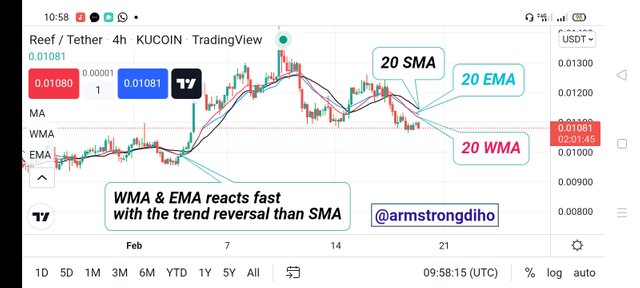

Identify Entry and Exit Points Using Moving Average. (Demonstrate with Screenshots)

Just as I said, the moving average is a trend based indicator, as such plays a vital position in identifying exit and entry points in the market. For a better understanding of how the MA can identify entry and exit points, I will be merging two moving averages for this purpose. However, to demonstrate this, I will be using a 20EMA and a 100 SMA period respectively. In this description, the 20EMA serves as the fast-moving average whereas the 100SMA serves as the slow-moving average, which represents the average price data points and will be used to define the direction of price.
Buy Position
Remember, our focus is on both moving average indicators, however, to identify a good entry for a buy position, the market must be in an uptrend. So, in a bullish trend, the price is observed to be trading above the 100SMA, which means the buyer is in control and we will consider the 100SMA as the dynamic support level. Then, we can focus on the 20EMA to look for a potential buy position.
**IMAGE SHOWING THE BUY POSITION **
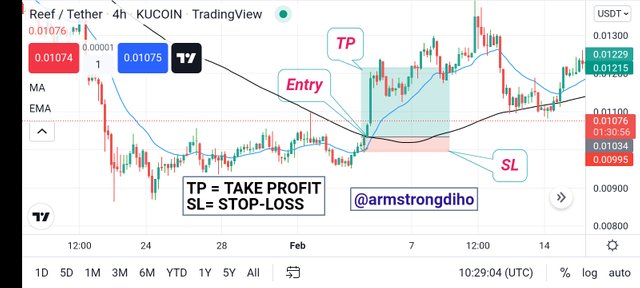
From the crypto chart above, we can observe the uptrend after the trend reversal. However, the 100SMA is well below the price and serving as the support level, the price retraced back to find support level on the 20 EMA giving us an entry signal. After that, a buy position can be executed when the price touches the 20 EMA and the stop loss at the 100 SMA level.
Sell Position
Here, the trend must be in a downtrend movement, as such, the two moving averages are above the price which means that the sellers are in control of the market. So, the 100SMA will serve as a dynamic resistance level, and we can look for a good sell entry signal. From the chart, we can observe the price rise and touch the resistance on the 20EMA and sell position can be triggered. The stop loss should be placed above the 100SMA level just as seen on the chart.
**IMAGE SHOWING THE SELL POSITION **
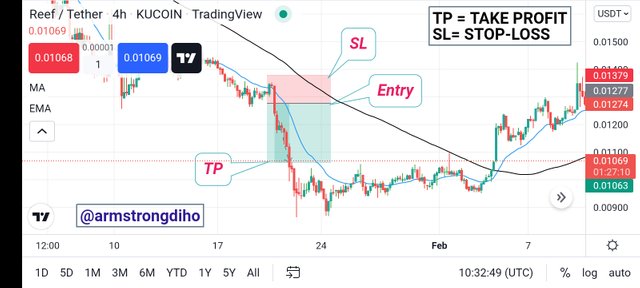
From the two illustrations, the moving averages are not only helpful to spot trends only but also plays a vital role to identify entry and exit positions. However, all it requires is to understand it and look for suitable parameters settings that suit your trading strategy. Remember, it is not ideal to trade with MA indicators when you don't understand how it works.

What do you understand by Crossover? Explain in Your Own Words.

Crossover involves the use of two moving average indicators and the concept of crossovers when two different MAs cross each other to generate market signals and it enables a trader to identify trend reversals as well. However, for crossover to generate signals, there is always a fast-moving average with a smaller period and a slow-moving average with a higher period respectively.
Nevertheless, the fast-moving average reacts to price faster and the slow-moving average reacts slower to price. So, when the fast-moving average crosses above the slow moving average, it signals uptrend reversal and buys trades opportunity can be produced. Conversely, when the faster-moving average crosses below the slower moving average, this signals a bearish reversal and sell trades opportunity can be produced. let's check out how we can make use of the crossover to identify a bullish and bearish trend with the potential buy and sell signals.
BULLISH CROSSOVER

In the crypto chart below, I have combined a fast-moving average of 50EMA and a slow 200EMA. So, a bullish crossover is observed when the 50EMA cross above the 200EMA and we can see good buy opportunities and stop loss is placed below the slow moving average (200EMA). This type of cross is called a Golden or Death Cross.
IMAGE SHOWING BULLISH CROSSOVER ON
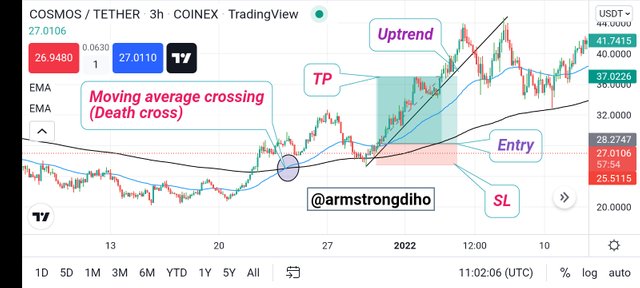
The above image shows the bullish crossover and the potential buy position after the death cross.

BEARISH CROSSOVER

A bearish crossover is observed when the 50 EMA cross below the 200EMA, we can see a sell position below the fast moving average (50EMA) and a stop loss placed above the slow moving average (200EMA). This type of cross is called a Golden or Death Cross.
IMAGE SHOWING BEARISH CROSSOVER ON
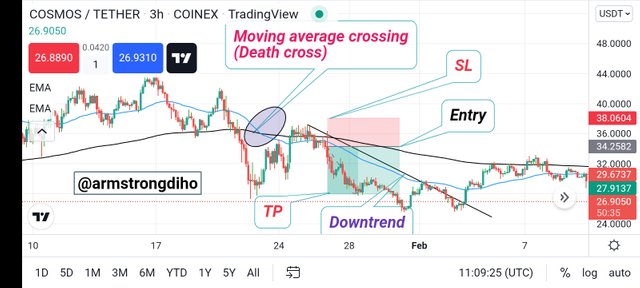
The above image shows the bearish crossover and the potential sell position after the death cross.
Trading with crossover is a good technique that functions basically on the trending market. So, a savvy trader who understands and interprets it works will obtain an entry during trend reversal. However, the setting of the parameters of the fast or slow-moving average requires the traders to know the best settings that will suit their trading style or strategy to avoid receiving false signals, which will end up losses of funds.

Explain The Limitations of Moving Average.

From the study, we have discussed lots of useful information of the MA and its usefulness to spot trends, support and resistance levels, buy and sell entry. However, I will say don't trust or depend on a technical indicator for signals because they're not reliable and can provide false signals in the market. No technical indicator can provide 100% accuracy, as such, it is not ideal to use a technical indicator like Moving Average as a standalone trading strategy as it is prone to provide false signals.
Let's check out the limitations of the moving average indicator for better understanding.
√ During the high volatile market, there is a lot of market noise observed, the MA can't flow properly with the trends, as such can signal false signals in the market which can lead to loss of funds. This implies that the MA can misinform critics into opening a trade when the price action has already emerged.
√ The Moving average obtains its current price data by relying heavily on historical price data points for its computation and doesn't provide information like the primary element of the price that might influence the price.
√ Using the MA as a trading system, it's hard to know the best period to use that will suit your trading style. So, using smaller periods on this indicator, develop many more signals as well as false signals as it reacts to price faster. On the other hand, Larger periods would merely generate signals for short term profits as it reacts slower to price.
√ Also, false trading signals can be obtained with MA when a trader choose a period in the wrong timeframe. For example, in a 4h timeframe the market might be observing a bearish trend in 20EMA and 50EMA might be false. This is because the MA is sensitive to each period selected.
√ In the domain of trading, a lot of traders sees the MA indicator as an old technical indicator due to the advancement of the markets mostly the influence of the fundamental factors that might affect the price.
√ The moving average is a trend based indicator and works well in a trending market, as such, can not detect signals during a sideways or range market.

Conclusion

Technical indicators are a very vital tool when performing technical analysis in the stock market regardless of their limitations. The moving average indicator is a trend based indicator that is useful to receive signals. From the lesson, we have understood the risks implicated in banking on the moving average for trade signals, as such, requires a better understanding of the indicators and good risk management.
Moving average can not provide 100% accuracy and is prone to give signals as it lags behind the current price and only focuses on the historical data points in its computation. With this effect, we shouldn't make use of the moving average as a standalone when making a trade decision.
It is ideal to combine the indicator with other technical indicators and the price action to maximise profit. To ride on the indicator, understanding and interpreting how it works and making use of periods that suit your trading system is very important.
THANKS FOR READING THROUGH
Cc: @shemul21
All images are taken from TradingView.com

